Red artillery in the Civil War. Part of 1
Speaking about the impact of the Civil War period on the tactical use of artillery and on the development of artillery during this period, it is necessary to take into account the characteristic conditions of the Civil War: lack of a unified front, insufficient communications and controllability, extreme instability of the location of troops, unreliability of rear communications, insufficient level of knowledge and training in special the branches of the military (if during the period of the First World War they retained their cadre, then during the Civil War they were diluted with a civilian element).
There is no need to talk about the technical evolution of artillery during the Civil War, while in tactical terms, a new type of war imposed on artillery (except for the requirements put forward by a conventional war) and specific requirements. The lack of systematic replenishment and rear ammunition led to a lack of ammunition; major repair of the material was not possible. Replenishment and replacement of unfit property were characterized, as a rule, by accident, and were usually made at the expense of the property taken away from the enemy or found in a busy locality. The shortness of battle, the instability of the front and the extensive use of purely maneuverable forms of combat made the main artillery of the Civil War field artillery - especially light and regimental.
The sprawling combat areas, the lack of necessary means of communication and often the disunity of the units caused the need for dispersal of artillery - scattering it on the regiments and battalions. The need for fire groups in groups larger than the battery was an exception. The main tactical units were platoons and individual guns - at best, batteries.
Thus, the Civil War led to a crushing of artillery, giving tactical independence even to individual guns. The fact that most of the battles during the Civil War were of reciprocal nature forced the artillery, in most cases, to use open positions in combat. This was facilitated by the impulse and enthusiasm inherent in the civil war fighters, as well as their inadequate technical readiness.
The independence of the infantry units with artillery attached to them and the possibility of their separation during the operation (sometimes for a long time) from the military association made it necessary to emphasize the expediency of the initial distribution of artillery among the infantry units and formations.
In its combat work, artillery during the Civil War had an increased moral impact on the enemy. Departure for open positions, the location of artillery at the level of infantry chains, and even ahead of it, was practiced very often - and often reached its goals not so much with the material result of firing as with moral influence.
The development of artillery units of the Red Army also had a great influence on the development of artillery.
After the beginning of the Civil War, in its partisan period, a significant number of individual platoons and batteries were formed by working groups and local councils, with the assignment of arbitrary names to them. But the main foundation was the artillery units merged into the Red Guard from the old Russian army.
1. One of the first batteries of the Red Army. 1918
After the transition of the Red Army in 1918 to the regular principles of organization, artillery inspectorates that arose in the armies and fronts began to reorganize the artillery.
In 1919, the artillery did not yet meet the established states - the batteries often had 2 - 3 guns. In the armies of the Western Front at this time was concentrated 30% of all available artillery. And the 2-x howitzer gun batteries were twice as large as the 4-gun. And in the heavy artillery there were only 3-x, 2-x and 1-gun batteries.
The whole 1919 year passed in the work of preparing and raising the educational level of the command staff, organizing universities, creating instructions, etc. At the same time, the ideological struggle was carried out - for liberation from common views of the artillery as a regimental infantry weapon, i.e. the property of the regiment. The idea of combining artillery into groups began to be consolidated. As a result, in the July offensive of the Western Front 1920, the number of artillery in armies doubled, and the total shortage in people, horses and materiel reaches "only" 50%. Thanks to the vigorous replenishment of artillery by a qualified command personnel, its overall level has increased significantly.
2. Classes at the artillery courses.
Artillery had a great influence on the course and outcome of the Civil War.
What capacities did the red artillery have?
By the end of 1917, the Russian army had 33 thousand guns, mortars and bomb bombers. But then during its demobilization, part of the armament was abandoned (abandoned), the other part was captured by the Germans during the offensive at the beginning of 1918, and finally, the part turned out to be faulty.
As a result, by the middle of 1918 there were about 10,5 thousand serviceable and, up to 2, thousand defective guns, mortars and bomb bombers. Of this amount in the army there were only 1300 serviceable systems. To the guns there was a considerable stock of shells - about 2,4 million pieces.
For arming the Red Army, it was decided to use domestic samples of the most modern artillery systems. Those were: in light field artillery - 76-mm gun mod. 1902 g. And 122-mm howitzer arr. 1909, and in heavy - 107-mm and 152-mm systems. Their firing range was 7 - 13 km. As the main anti-aircraft gun remained 76-mm gun mod. 1915
3. 76-mm gun obr. 1902
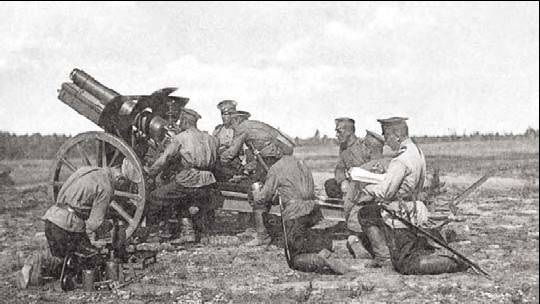
4. Artillery calculation of the Russian Imperial Army in 122-mm howitzers arr. 1909
5. Fighters anti-aircraft gunners in the classroom.
In the course of hostilities, young Soviet artillery was replenished with weapons: from the reserves of the Russian army, proceeds from industry and captured trophies. The release of guns during the war years was small - no more than 700 units (enterprises worked irregularly). More than 1600 guns and up to 3,5 million shells were captured as trophies. In addition, about 1000 guns were repaired. Total red troops in 1918 - 1920. received up to 4 thousand guns and more than 7,5 million shells. Moreover, on fleets and the flotillas had 600 guns with a caliber of 75 mm and above.
The vanguard role in the creation of artillery of the Red Army belonged to Petrograd — where the formation of the 1 Corps of the Red Army took place. The corps consisted of heavy artillery and mortar battalions, a light artillery brigade and trench artillery. These units and subunits, which had not yet completed the formation, served as the main base for replenishing the artillery of the active army - especially during the February offensive of the German forces. By May 1918, the corps artillery numbered 3260 people and 53 guns.
At the end of 1917, the Artillery Directorate headed by the Chief was formed under the High Command - the latter replaced the field inspector-general of the artillery under the Supreme Commander. And in March, 1918 reestablished the position of the Field Artillery Inspector and its management to unite the general management of the artillery. The solution of this problem was completed in November by 1918 with the formation at the commander-in-chief of the Field Staff of the RVSR, where the management headed by the artillery inspector Yu. M. Scheideman — which led the special purpose heavy artillery (TAON) during the First World War — was organized.
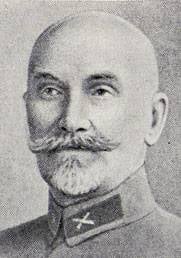
6. Yu. M. Scheideman.
The directorates of artillery inspectors were also deployed in the fronts and armies. They were engaged in the combat use of artillery. The artillery inspector reported directly to the commander of the front (army) troops.
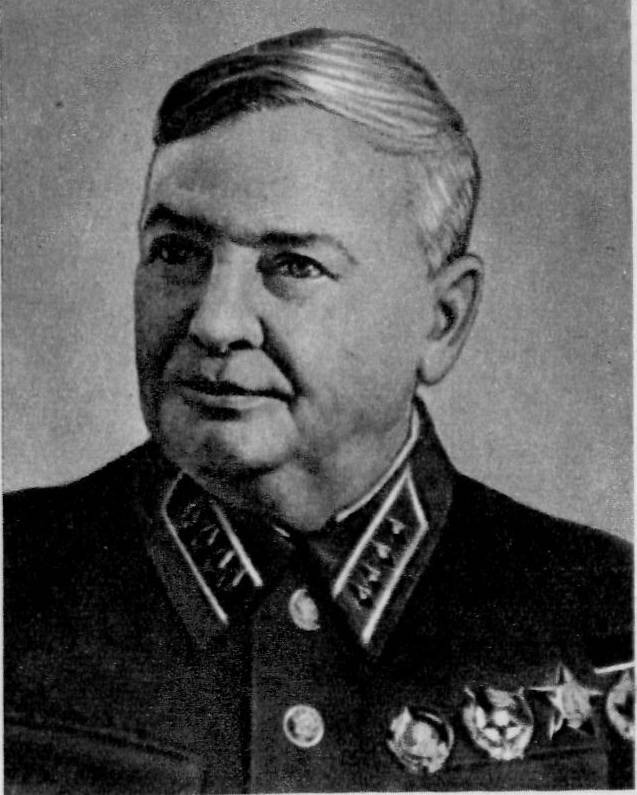
7. V.D. Grendal, in 1917 - Colonel, Commander of the 1-th Sea Heavy Artillery Regiment. During the Civil War, he was an inspector of artillery of the Southern (1918-1919) and South-Western (1920) fronts.
Simultaneously with the formation of the central apparatus, front-line, army and local government bodies, a uniform structure of military artillery was developed. However, the proposed organization, as a rule, did not correspond to either the material capabilities or the nature of the armed struggle. In 1918, it was not possible to find the necessary organizational forms (for example, according to the November plan it was planned to form 47 rifle divisions - but it turned out that they lacked about 3,5 thousand guns, so we had to retreat from the states and restrict ourselves to the reduced composition of artillery entered into combined arms).
The maneuverable nature of the war necessitated the formation of cavalry divisions. Such a division provided for attaching an equestrian artillery division of the 4-battery pack: three 4-gun batteries, 76-mm guns and one battery of British 114-mm howitzers.
Taking into account the experience of the First World War, a reserve of artillery of the Main Command was recreated on the basis of parts of the TAON - as a means of quantitative and qualitative reinforcement of troop artillery. By July 1918, there were 28 battalions and TAON batteries. By the end of the year, three TAON artillery brigades (11 divisions) were formed, reserve and reserve artillery brigades comprising 198 120 heavy guns - 305-mm caliber.
At the same time, attempts were made to create mortar units, and the formation of a separate mortar division was started consisting of five batteries: two heavy - four 240-mm mortars and three light ones - eight 58-mm mortars each.
Thus, the artillery of the Red Army was subdivided into field, trench, heavy artillery of special purpose and anti-aircraft.
Creating a regular army, equipping it with modern equipment required a scientific development of a number of problems, including problems of armament and the use of artillery. To this end, a number of activities are being carried out to create centers of scientific artillery thought. In this regard, the restoration and restructuring of the Artillery Committee are being undertaken, and also the Commission of Special Artillery Experiments (KOSARTOP) is being created.
Before the Artillery Committee in the summer of 1918, the task was to review and correct the artillery charters and instructions. Developed by the committee in 1918 - 1920. Charters and manuals played an important role in the combat training of artillery units and the training of commanders.
Of particular importance in the summer of 1918 was the Eastern Front, on which both sides had small artillery. The Soviet forces included artillery platoons, batteries, teams, and even brigades — but the number of serviceable guns in them ranged from 3 to 35%.
In the summer of 1918, the tactic of "echelon war" —that is, the conduct of hostilities, mainly along railways — was a characteristic form of hostilities. Widely used tools mounted on railway platforms. Fire on the enemy was carried out from the platforms, most often by direct fire. In some cases, when the units dismounted, and the train itself was retracted, the fire was fired from closed firing positions.
With the expansion of the theater of operations and the abandonment of the tactic of "echelon war", artillery actions in the field are increasingly being used - with firing from open and closed firing positions.
To strengthen the Eastern Front, by mid-June, more than 160 guns and 4 armored trains were deployed from the western sectors. At the same time, river ships were armed with artillery and machine guns. By September, front artillery numbered over 260 guns.
With the accumulation of experience begins to practice centralized management of artillery. When 1918 attacked Kazan in September, the 5 Army’s artillery near the city was united under the command of the army’s artillery commander and divided into groups of attacking troops in two areas: the right - 16 guns, the left - 19 guns. In the order on artillery units, each platoon of the right sector indicated specific targets - which the artillery should have struck during the artillery preparation period. In the future, the artillery was assigned the task of continuous support for the advancing infantry. The artillery of the left sector was subordinate to the commander of the left-bank group of troops and was used at his discretion. In addition, the actions of the artillery of the army were linked to the actions of the artillery of the Volga flotilla - one of the main tasks of which was to destroy the observation posts and white batteries in the Upper Uslon area. On September 10, as a result of the concentrated efforts of infantry, flotilla and artillery, Kazan was taken.
In the south of the country by the autumn of 1918, bloody battles took place in the Tsaritsyn area. Since October, the Southern Front has become the main front of the Soviet Republic. Front artillery numbered over 400 guns.
The most intense situation was in the Tsaritsyn direction, where the Cossack units, with 150 guns, sought to capture the city. They were opposed by the Soviet 10-I army, which had in its composition more than 260-ti field and guns mounted on armored trains. The command personnel of the artillery overwhelmingly had a good professional training.
Particularly stress battles reached in mid-October. In the area of Sadovaya Station on the night of October 17, all the artillery of the central sector — the total number of 4 field guns before the 100 — was mounted on the expected direction of the main strike of the whites on the 30-km front. As a result, it was possible to achieve a double superiority over the opponent, who had only 60 guns. The artillery density created — up to the 25-30 guns on the 1 km of the front — was greatest during the entire period of the Civil War.
The task was to repel the attack of a strong strike force, to inflict damage on the guns and infantry with white fire and to drop it from Tsaritsyn. With the dawn of October 17, under the cover of strong gunfire in the central sector, the Whites launched an offensive. The infantry moved in a deployed system, having cavalry in the second echelon. Having received the order not to open fire to the appropriate team, the fire weapons of Tsaritsyn’s defenders were silent. When the whites approached the lines of defense on 500, the whole mass of artillery and rifle weapons opened a hurricane of fire. Using the results of the fire, the red pieces counterattacked and discarded the whites.
At the same time, the Northern Front also had to be strengthened. With increasing tensions in military operations, the number of guns in the troops defending the northern borders increased. From September to December 1918, their number increased from 40 to 112. They were used more frequently in prouadno and pobatarino - in the directions of the most active actions. Successful was the centralization of the management of artillery in the actions of the detachment that was part of the Northern Front - on the railway direction Vologda - Arkhangelsk.
Продолжение следует ...
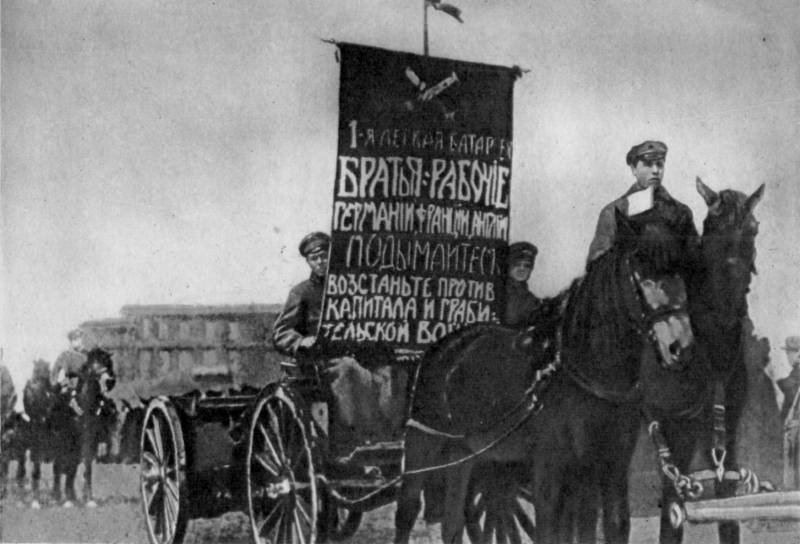
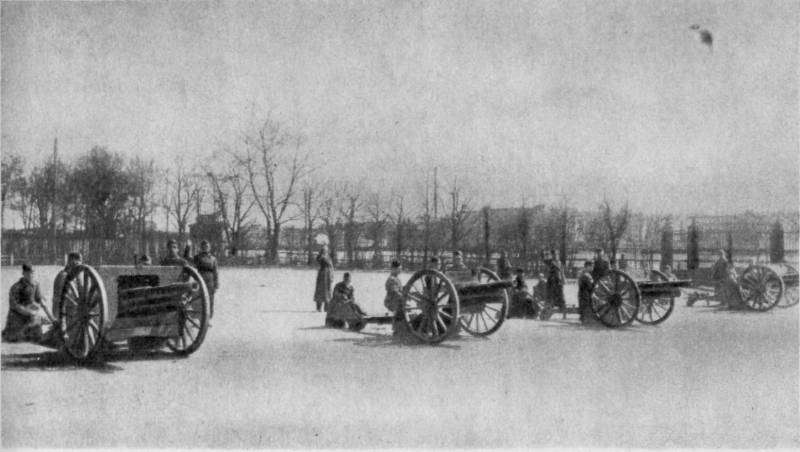
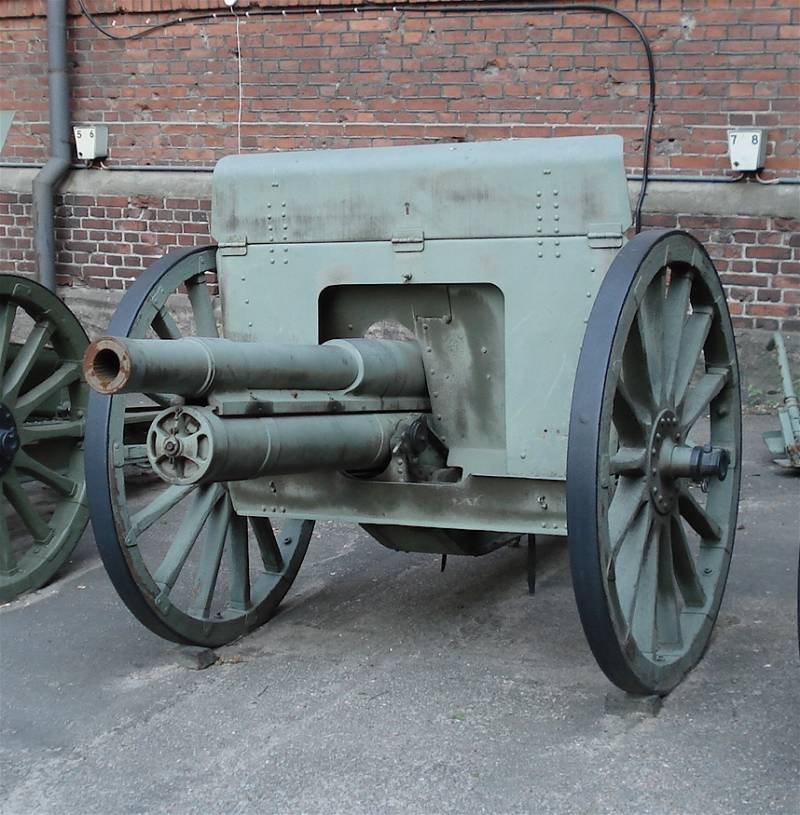
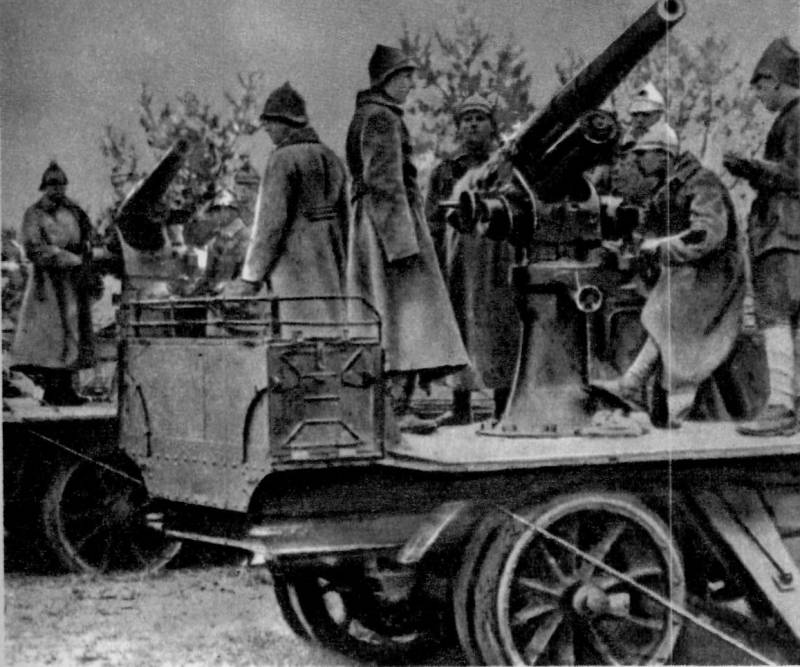
Information